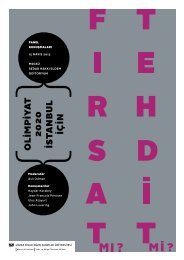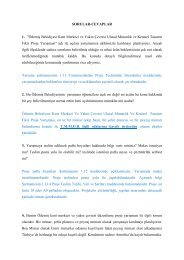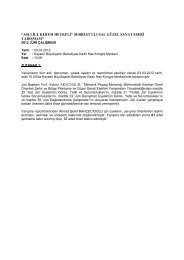VitrA ÃaÄdaÅ Mimarlık Dizisi - Arkitera
VitrA ÃaÄdaÅ Mimarlık Dizisi - Arkitera
VitrA ÃaÄdaÅ Mimarlık Dizisi - Arkitera
Create successful ePaper yourself
Turn your PDF publications into a flip-book with our unique Google optimized e-Paper software.
One of the most important tourism centers and a significant example of modern architecture,<br />
Hotel Libertas was abandoned as a ruin for fourteen years after its war-time<br />
destruction. The building, worn down by the harsh climatic conditions, has been totally<br />
renovated, preserving only the structural system. The facility has acquired new functions<br />
like a spa and a coastal arrangement located in the annex constructed at the<br />
coast levels. In addition to the original middle block, the levels added to the upper<br />
section have increased the number of guest rooms and halls. Since the renovation, the<br />
hotel houses 315 guest rooms with a bed capacity of 625, three restaurants, a spa and<br />
health center, leisure units and meeting and conference halls.<br />
✎<br />
Located in the Gorica Svetog Vlaha district one kilometer away from the historical city<br />
of Dubrovnik, one of the most popular touristic cities of Croatia; Hotel Libertas constructed<br />
within a bay surrounded by steep rocks has been designed by the famous<br />
Croatian architect Andrije Cicin-Sain and his partner Zarka Vinceka, as the consequence<br />
of a limited architectural competition dated 1968 where six teams were invited.<br />
^<br />
^<br />
^<br />
Together with the functional mass housing blocks realised by the cheap labor of the<br />
early socialist period, the successful examples of tourism architecture built at the Adriatic<br />
Coast during the 1960s as most significant products of post-war architecture constitute<br />
the architectural wealth of former Yugoslavia. With its structure that spreads out<br />
on the steep slope like a cascading amphitheater, this 400 bed modernist hotel building<br />
clearly reflects the purist and functionalist approach of the period. Cicin-Sain’s matured<br />
search for clarity, boldness and the strenght of his architectural statement contribute to<br />
the avant-garde and futurist spirit of his work. Following the natural topography of the<br />
sloped site and the coastline with its cascaded form and horizontal lines of reinforced<br />
concrete terraces, the hotel block successfully blends with the natural formation of the<br />
Dalmatian coast with its green terraces that cascade and flow from the upper levels to<br />
the lower levels.<br />
The hotel opened in 1974 has stayed in service until the Yugoslavian Civil War in 1991,<br />
and has been vastly destroyed during the war, leaving the building as an abandoned<br />
wreck from the declaration of independence in Croatia until the sale of the building in<br />
2002. Following its purchase by the Rixos hotel chain in 2004, the renovation process<br />
has been initiated, with the construction of additional storeys above the entrance section,<br />
the addition of a transparent vertical circulation shaft that interrupts the horizontal<br />
effect of the facade and the construction of new sections at the coast level to convert<br />
the existing units into spa suits. During the renovation process, the elaborate efforts to<br />
revitalize Libertas Hotel as a part of the modern architectural heritage have inevitably<br />
brought some changes in the original structure and appearance of the hotel, in order<br />
to respond to the requirements of contemporary hotel management and the changed<br />
expectations for comfort.<br />
^<br />
^<br />
^ ^<br />
82

















